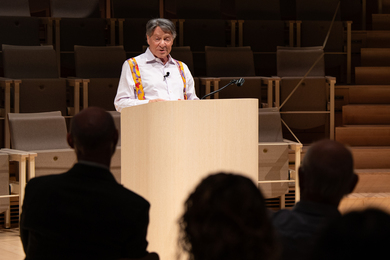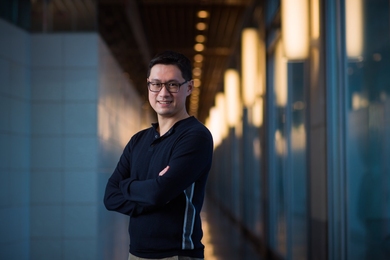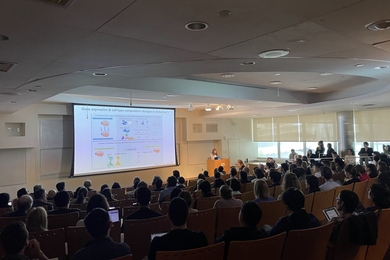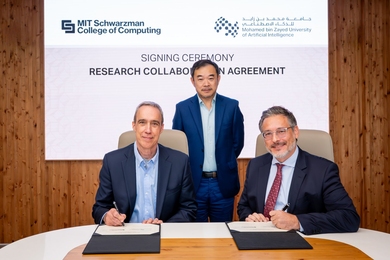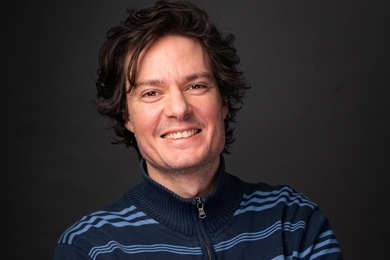As the world has become less analog and more digital — as tape decks and TV antennas have given way to MP3 players and streaming video — electrical engineers’ habits of thought have changed, too. In the analog world, they used to think mostly in terms of quantities such as voltage, which are continuous, meaning they can take on an infinite range of values. Now, they tend to think more in terms of 0s and 1s, the binary oppositions of digital logic.
Since the completion of the Human Genome Project, two thriving new disciplines — synthetic biology and systems biology — have emerged from the observation that in some ways, the sequences of chemical reactions that lead to protein production in cells are a lot like electronic circuits. In general, researchers in both fields tend to analyze reactions in terms of binary oppositions: If a chemical is present, one thing happens; if the chemical is absent, a different thing happens.
But Rahul Sarpeshkar, an associate professor of electrical engineering in MIT’s Research Laboratory of Electronics (RLE), thinks that’s the wrong approach. “The signals in cells are not ones or zeroes,” Sarpeshkar says. “That’s an overly simplified abstraction that is kind of a first, crude, useful approximation for what cells do. But everybody knows that’s really wrong.”
At the Biomedical Circuits and Systems Conference in San Diego in November, Sarpeshkar, research scientist Lorenzo Turicchia, postdoc Ramiz Daniel and graduate student Sung Sik Woo, all of RLE, will present a paper in which they use analog electronic circuits to model two different types of interactions between proteins and DNA in the cell. The circuits mimic the behaviors of the cell with remarkable accuracy, but perhaps more important, they do it with far fewer transistors than a digital model would require.
The work could point the way toward electronic simulations of biological systems that not only are simpler to build and more accurate, but run much more efficiently. It also suggests a new framework for analyzing and designing the biochemical processes that govern cell behavior.
Shades of gray
A transistor is basically a switch: When it’s on, it conducts electricity; when it’s off, it doesn’t. In a computer chip, those two states represent 0s and 1s.
But in moving between its nonconductive and conductive states, a transistor passes through every state in between — slightly conductive, moderately conductive, fairly conductive — just as a car accelerating from zero to 60 passes through every speed in between. Because the transistors in a computer chip are intended to perform binary logic operations, they’re designed to make those transitional states undetectable. But it’s the transitional states that Sarpeshkar and his colleagues are trying to exploit.
“Let’s say the cell is a pancreatic cell making insulin,” Sarpeshkar says. “Well, when the glucose goes up, it wants to make more insulin. But it’s not bang-bang. If the glucose goes up more, it’ll make more insulin. If the glucose goes down a little, it’s going to make less insulin. It’s graded. It’s not a logic gate.”
Treated as an analog device, a single transistor has an infinite range of possible conductivities, so it could model an infinite range of chemical concentrations. But treated as a binary switch, a transistor has only two possible states, so modeling a large but finite range of concentrations would require a whole bank of transistors. For large circuits that model sequences of reactions within the cell, binary logic rapidly becomes unmanageably complex. But analog circuits don’t. Indeed, analog circuits exploit the same types of physical phenomena that make the cellular machinery so efficient in the first place.
“If you think about it, what is electronics?” Sarpeshkar says. “It’s the motion of electrons. What is chemistry? Chemistry is about electrons moving from one atom or molecule to another atom or molecule. They must be deeply connected: They’re both about the electrons.”
Validation
For their new paper, the RLE researchers performed their own biological experiments, measuring the effects of gradually increasing the concentrations of two different proteins within the cell. Both proteins prompt the cell to start producing other proteins, but they do it in different ways: One of them binds to a strand of DNA and causes the cell to increase production of a particular protein; the other deactivates a protein that’s suppressing a protein’s production.
Sarpeshkar and his colleagues were able to model both processes using circuits with only eight transistors each. Moreover, the circuits turned out to form mirror images of each other, representing the difference between directly activating protein production and deactivating a deactivator. And finally, the circuits modeled the interactions of the genes and proteins with remarkable accuracy.
“The concept of using a single transistor to implement an entire equation — which, implemented on a digital computer, would take several lines of code, and if you look inside the box it would be millions of transistors — is definitely an advance,” says Gert Cauwenberghs, a professor of bioengineering and biology at the University of California at San Diego. “The extreme variability in biological systems, and the fact that the systems are still resilient against variations, would suggest that analog circuits, which have some of the same physical thermodynamic principles and noise embedded in them, would be a good implementation platform.”
Cauwenberghs cautions that to be useful to biologists, an analog model of genetic circuits would have to be much more complex than the one that the RLE researchers describe in their new paper. Building such a model, he says, will require as much work by biologists, in generating accurate data about chemical concentrations in the cell, as by electrical engineers. But “there’s definitely synergy between these two domains,” he says.
Since the completion of the Human Genome Project, two thriving new disciplines — synthetic biology and systems biology — have emerged from the observation that in some ways, the sequences of chemical reactions that lead to protein production in cells are a lot like electronic circuits. In general, researchers in both fields tend to analyze reactions in terms of binary oppositions: If a chemical is present, one thing happens; if the chemical is absent, a different thing happens.
But Rahul Sarpeshkar, an associate professor of electrical engineering in MIT’s Research Laboratory of Electronics (RLE), thinks that’s the wrong approach. “The signals in cells are not ones or zeroes,” Sarpeshkar says. “That’s an overly simplified abstraction that is kind of a first, crude, useful approximation for what cells do. But everybody knows that’s really wrong.”
At the Biomedical Circuits and Systems Conference in San Diego in November, Sarpeshkar, research scientist Lorenzo Turicchia, postdoc Ramiz Daniel and graduate student Sung Sik Woo, all of RLE, will present a paper in which they use analog electronic circuits to model two different types of interactions between proteins and DNA in the cell. The circuits mimic the behaviors of the cell with remarkable accuracy, but perhaps more important, they do it with far fewer transistors than a digital model would require.
The work could point the way toward electronic simulations of biological systems that not only are simpler to build and more accurate, but run much more efficiently. It also suggests a new framework for analyzing and designing the biochemical processes that govern cell behavior.
Shades of gray
A transistor is basically a switch: When it’s on, it conducts electricity; when it’s off, it doesn’t. In a computer chip, those two states represent 0s and 1s.
But in moving between its nonconductive and conductive states, a transistor passes through every state in between — slightly conductive, moderately conductive, fairly conductive — just as a car accelerating from zero to 60 passes through every speed in between. Because the transistors in a computer chip are intended to perform binary logic operations, they’re designed to make those transitional states undetectable. But it’s the transitional states that Sarpeshkar and his colleagues are trying to exploit.
“Let’s say the cell is a pancreatic cell making insulin,” Sarpeshkar says. “Well, when the glucose goes up, it wants to make more insulin. But it’s not bang-bang. If the glucose goes up more, it’ll make more insulin. If the glucose goes down a little, it’s going to make less insulin. It’s graded. It’s not a logic gate.”
Treated as an analog device, a single transistor has an infinite range of possible conductivities, so it could model an infinite range of chemical concentrations. But treated as a binary switch, a transistor has only two possible states, so modeling a large but finite range of concentrations would require a whole bank of transistors. For large circuits that model sequences of reactions within the cell, binary logic rapidly becomes unmanageably complex. But analog circuits don’t. Indeed, analog circuits exploit the same types of physical phenomena that make the cellular machinery so efficient in the first place.
“If you think about it, what is electronics?” Sarpeshkar says. “It’s the motion of electrons. What is chemistry? Chemistry is about electrons moving from one atom or molecule to another atom or molecule. They must be deeply connected: They’re both about the electrons.”
Validation
For their new paper, the RLE researchers performed their own biological experiments, measuring the effects of gradually increasing the concentrations of two different proteins within the cell. Both proteins prompt the cell to start producing other proteins, but they do it in different ways: One of them binds to a strand of DNA and causes the cell to increase production of a particular protein; the other deactivates a protein that’s suppressing a protein’s production.
Sarpeshkar and his colleagues were able to model both processes using circuits with only eight transistors each. Moreover, the circuits turned out to form mirror images of each other, representing the difference between directly activating protein production and deactivating a deactivator. And finally, the circuits modeled the interactions of the genes and proteins with remarkable accuracy.
“The concept of using a single transistor to implement an entire equation — which, implemented on a digital computer, would take several lines of code, and if you look inside the box it would be millions of transistors — is definitely an advance,” says Gert Cauwenberghs, a professor of bioengineering and biology at the University of California at San Diego. “The extreme variability in biological systems, and the fact that the systems are still resilient against variations, would suggest that analog circuits, which have some of the same physical thermodynamic principles and noise embedded in them, would be a good implementation platform.”
Cauwenberghs cautions that to be useful to biologists, an analog model of genetic circuits would have to be much more complex than the one that the RLE researchers describe in their new paper. Building such a model, he says, will require as much work by biologists, in generating accurate data about chemical concentrations in the cell, as by electrical engineers. But “there’s definitely synergy between these two domains,” he says.


